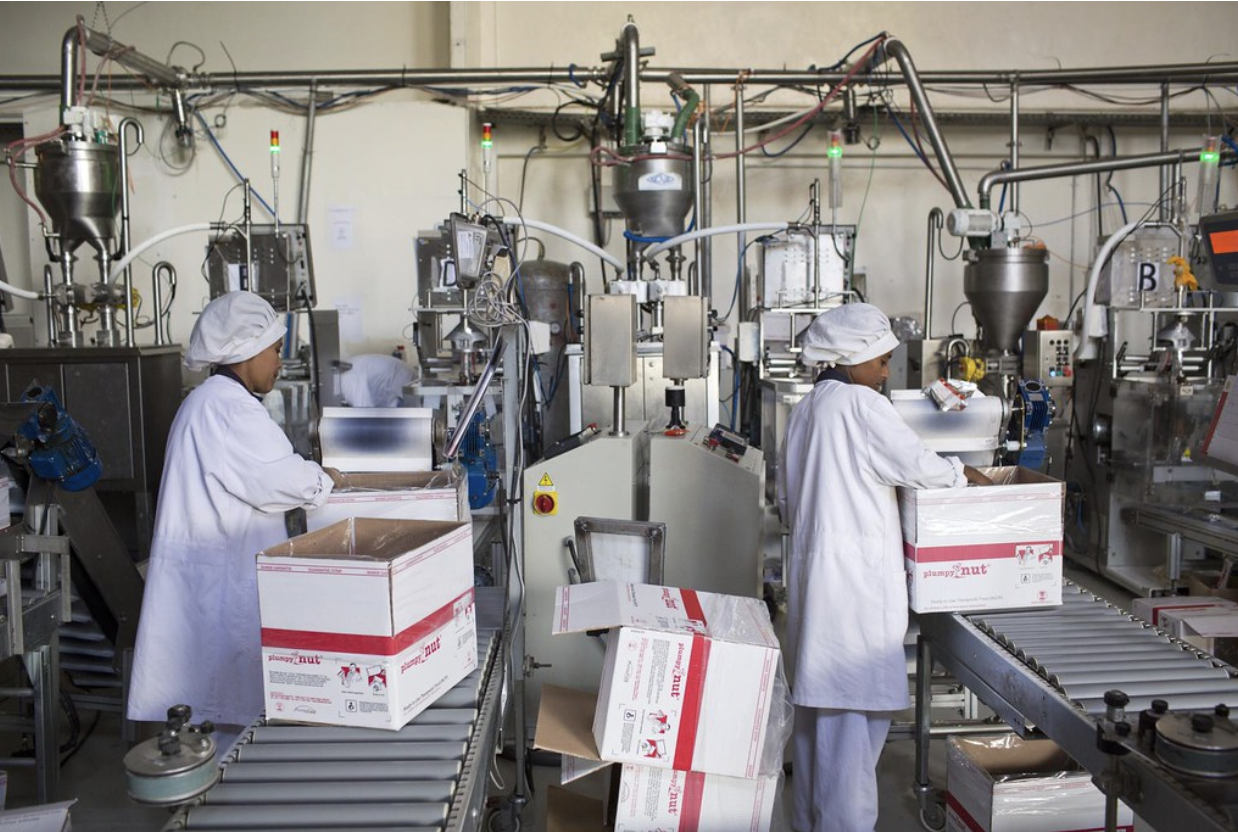Real-time humanitarian aid stock level alerts could soon become a reality
A blog by Alasdair Davies, a Frontier Tech Hub Implementing Partner.
We’re preparing to trial GeoSeals, our solution to real-time reporting of humanitarian aid stock levels for aid agencies, helping them to manage supply chains cost-effectively.
It was a warm afternoon in late May 2022, in a coffee shop in Portsmouth, when Ruby Hill and I first questioned “how cost-effectively could we track a bar of soap?”. We were questioning which tracking technologies and approaches could best tackle the challenge presented to us - track humanitarian aid parcels from source to destination cost-effectively, provide a geo-referenced delivery location on arrival and report the status of the aid parcel (not consumed and still in storage, or open and so consumed).
When you’re dealing with potentially hundreds of thousands of aid items moving throughout a supply chain, we knew that our tracking system and methodology was going to need to be very low-cost, simple to implement, easy to scale, and possible to introduce into existing aid supply chains. Backed by the team from the Frontier Tech Hub, we’re excited to announce that after 18 months of development and support, we are now preparing to trial GeoSeals - our solution to generating real-time humanitarian aid stock level alerts for aid agencies seeking to understand and manage their supply chains cost effectively.
(Figure 1) It was a warm afternoon in late May 2022, in a coffee shop in Portsmouth, when Ruby Hill and I first questioned “how cost-effectively could we track a bar of soap?”.
Importantly, GeoSeals has been developed in situ with technical advisors at the FCDO throughout its development, enabling us to devise a viable, cost-effective solution that has been peer-reviewed to ensure it is both fit-for-purpose and offers value to aid agencies seeking to monitor and understand their supply chains.
At its heart, GeoSeals utilizes passive RFID technology coupled with a special “sticker” designed to easily integrate into existing aid supply chains. The sticker is added to aid parcels at factories and production facilities, and when removed or broken (i.e. the parcel is opened) the location and event is transmitted securely using cellular / satellite connectivity via GeoSeal hubs installed at clinics, warehouses or even in the back of an aid distribution vehicle where aid is either stored or distributed from.
Because we use a form of batteryless, passive RFID, it could cost as low as £0.10p to tag an aid parcel, bringing us back to that initial question - “how cost-effectively can we track a bar of soap? - asked 18 months ago. After researching a range of possible tagging solutions and technologies, we’re confident that GeoSeals presents the best value for money in terms of a system capable of generating geo-reference locational data (where the aid is physically) and importantly, if it has been consumed (aid parcel opened) or is still in storage (aid parcel arrived but has not been consumed) at as low of a price point as possible.
“Because we use a form of batteryless, passive RFID, it could cost as low as £0.10p to tag an aid parcel.”
With development hardware nearing competition, we’re about to embark on a scoping trip to present the GeoSeals solution, technology and platform to agencies operating in Ethiopia in a few weeks time before preparing for a real-world trial.
(Figure 2) GeoSeal tracking stickers can be introduced into supply chains at the factory level and are suitable for fitment on different sized packages and/or packaging materials.
Who needs to know? Generating and delivering real-time alerts for aid agency workers and logistical teams
We realized early on that tracking and monitoring aid parcels was only half of the problem. Data generated from GeoSeals needed to flow into the hands of aid agency workers and logistical teams so they could take meaningful action if GeoSeals was to have an impact. We also needed to ensure that any data generated by GeoSeals could be stored securely locally (i.e encrypted), could be securely transmitted for review (i.e over HTTPS or similar encrypted connectivity) and needed to take into account that GeoSeals hubs would ultimately be installed at remote clinics, health centers and other facilities that may not have mains electricity or any form of wireless infrastructure, such as WiFi / cellular connectivity, so we needed a system that could self-recover in the event of power cuts and was capable of operating within poor data connectivity environments.
“We realised early on that tracking and monitoring aid parcels was only half of the problem. ”
To cater for this eventuality, we settled on the use of the MQ Telemetry Transport protocol (MQTT). MQTT is a Client Server publish/subscribe messaging transport protocol. It is lightweight, open, simple, and designed to be easy to implement. These characteristics made it ideal for GeoSeals as it catered for constrained environments, such as receiving data within a remote location and then communicating data back to a central service via Machine to Machine (M2M) services and devices where a small code footprint is required and/or network bandwidth is at a premium, which is the case for GeoSeals.
If we break down how MQTT works, it can be described as a system that is based on clients (devices running client firmware) that can be both publishers of data (i.e I have an ID from a GeoSeal tagged aid parcel I want to tell you about), or subscribers to data (i.e I want to know which aid parcels you’ve detected, please tell me as soon as you know). An MQTT client can be any device (from a microcontroller running in a GeoSeals hub on a wall in a clinic, up to a full-fledged server running within an aid agency’s headquarters). They all run an MQTT library and connect to an MQTT broker over a network, be that over WiFi, cellular, satellite or anything in between.
The “Broker” is at the heart of any publish/subscribe protocol. Depending on the implementation, a broker can handle thousands of concurrently connected MQTT clients, so in our case, the GeoSeals broker (software) could run inside a GeoSeals hub and would accept any number of GeoSeals RFID scanners acting as clients, meaning an aid agency’s warehouse could have 10 - 20 scanners working across a wide area, all reporting to an MQTT Broker that then reports all of this data back to a system that wants to know - in this case, an aid agency’s services where data is then visualized and information acted upon. In this simple way, MQTT Clients and Brokers at the software level can be mixed and matched to easily scale GeoSeals and cater for different scenarios.
Additionally, MQTT caters for poor data links where a signal may be lost (remote locations with poor connectivity), enabling a remote MQTT Broker to poll a client and receive any missing or lost data bilaterally, preventing issues where clients are only communicating to a service, which helps to provide a stable data service and builds integrity throughout the system regardless of scale.
(Figure 3) GeoSeals has been built around the use of the MQ Telemetry Transport protocol (MQTT) to ensure scalability, data integrity and ease of integration with existing systems hosted by aid agencies such as stock management software and visualization systems.
When thinking ahead to the end users of the GeoSeals system / platform, it’s also important to think about who may want to consume GeoSeals data, where, how and on what device. One feature of GeoSeals is the prevention of “stockouts” (situations where a rush on demand overwhelms supply in a short period of time). Data regarding possible stockout events needs to flow into the hands of aid agency workers quickly and effectively so they are able to take action. Therefore, through the use of MQTT client applications running on everyday devices, i.e smartphones or tablets, we can push and present data in the form of alerts, identify important tagged aid (i.e critical aid parcels that a particular aid agency worker may want to know arrived safely), or provide a means to forwarding data to other agency workers or logistical specialists quickly and effectively from everyday devices, such as smartphones, securely and quickly to save vital time in urgent situations.
We’ll report back after our upcoming in-country scoping trip with more updates on the GeoSeals project as we prepare for our full trial later in the year.
If you’d like to dig in further…
📚 Explore learnings from the pilot’s first sprint — ‘Can we reveal the final destination of humanitarian aid?’
📚 Read learnings from the pilot’s second sprint — ‘Can you cost effectively track soap?’
⛴️ Dive into the pilot’s profile — Smart Geo-Seals to Track Delivery of Humanitarian Aid



